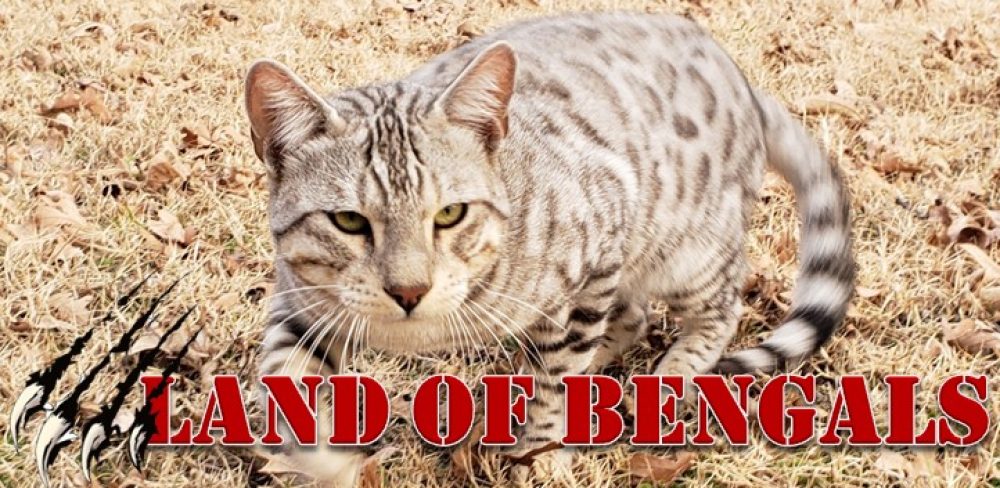
Just like humans, about 60-75% of a Bengal’s body weight is made up of water. Your Bengal needs a healthy amount of water to survive and to maintain his/her health and vitality. When living in the wild, they obtain water from the moisture content in their food. This includes prey like insects, birds, and rodents, which also contain high water content. That is why a RAW FOOD diet is highly recommended.
Water helps your Bengal’s body to:
- Digest food
- Acts as a lubricant and shock absorb
- Regulates body temperature
- Main constituent of cells, tissues and organs
- Maintains the vascular volume and enables blood circulation
- Performs the critical function of transporting nutrients and removing wastes.
I cannot emphasize enough the need for your Bengal to consume plenty of water. Sadly, we often overlooked their need for water because there is no industry that stress about the importance of water as a vital nutrient. I guess because it is not profit on it.

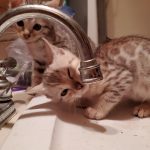

Encouraging hydration is extremely important. However just providing a bowl of fresh, clean water does NOT ensure your Bengal will instinctive drink the water he/she needs in order to stay well hydrated and healthy due to their naturally low thirst drive. As you may already know Bengals came from a breed between cats and Asian Leopards. Cats were originally desert animals (Egypt) and Asian Leopard, well nature made it difficult to always find fresh water. So in both cases they had to evolve and adapt to maintain hydrated by other means others than drinking water. From an evolutionary standpoint they derived almost all they water they needed from their diet.
But… How Much Water Is Enough?
Well I would say that all depends and according to the Nutrition Research Council’s “Nutrient Requirements of Dogs and Cats”. For a cat to maintain a hydrated state, the level of moisture of the food they consume needs to be at least 63%, because they will be dehydrated at 61%.
The moisture content of cat foods varies dramatically from wet to dry:

As you can see in the picture, dry food diets create a state of chronic dehydration, so unless your Bengal consumes a LOT of additional of water he/she can suffer from cardiovascular, respiratory, nervous system, brain, digestive, kidneys and/or liver diseases. Chronic kidney disease is the number one cause of death in cats over 5 years of age.
The average of water that your Bengal will needs to consume if he/she is eating dry food is about 1 to 2 cups of water per day (to equal the amount of water a cat eating a canned food or raw food). It seems a little bit too much, right? Well, while wet/raw foods provide enough water, the dry food deprives the body of water because the water is needed to process the food eaten by your Bengal (it takes water to metabolize the nutrients in food).
And more important, if your Bengal doesn’t drink water naturally, how you can may sure that he/she keeps hydrated? Well, feed them raw food will do the trick (and you’re not paying for the water that adds weight to the canned foods).
Here are some tips to encourage water intake:
Your Bengal LOVE to drink running water (just turn on a faucet and you will see). However we don’t want to waste water and keep the water running the whole day, right? Well, re-circulating water fountains are very attractive for them because emulate the running water in a faucet. Kittens and adults love these kind of fountains. Just remember to replace the filters.
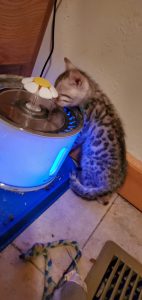
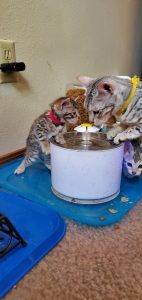

Remember that increasing the water intake will increase the need of your Bengal to relieve himself /herself so having multiple, clean, fresh litter boxes should be a must.
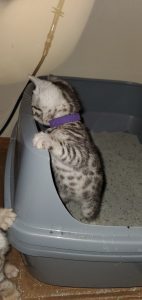
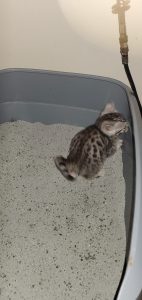
You also can add a little bit of warm water to your Bengal’s raw food. Warm water will be ideal because will help to the illusion of a “fresh kill”. You also can add different kind of liquids or even give it to them separately, like chicken/beef/pork/ lamb broth.

Other tip is to have more than one water station around your house, in many cases this will stimulate your Bengal to drink more frequently. Out of sight, out of mind is very true in this instance.
Water is life. Water is health. Please ensure your Bengal has a raw diet and provide and encourage the drinking of additional water!

